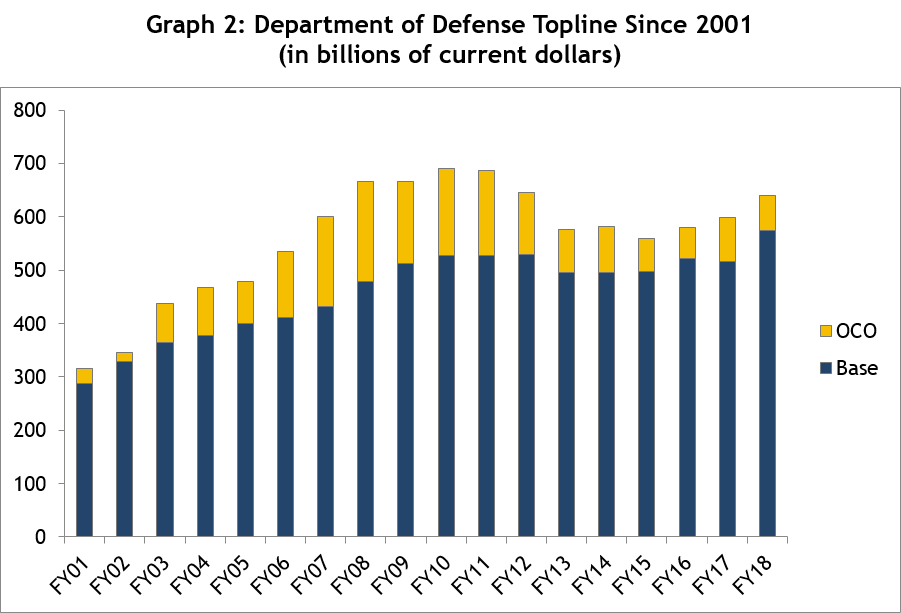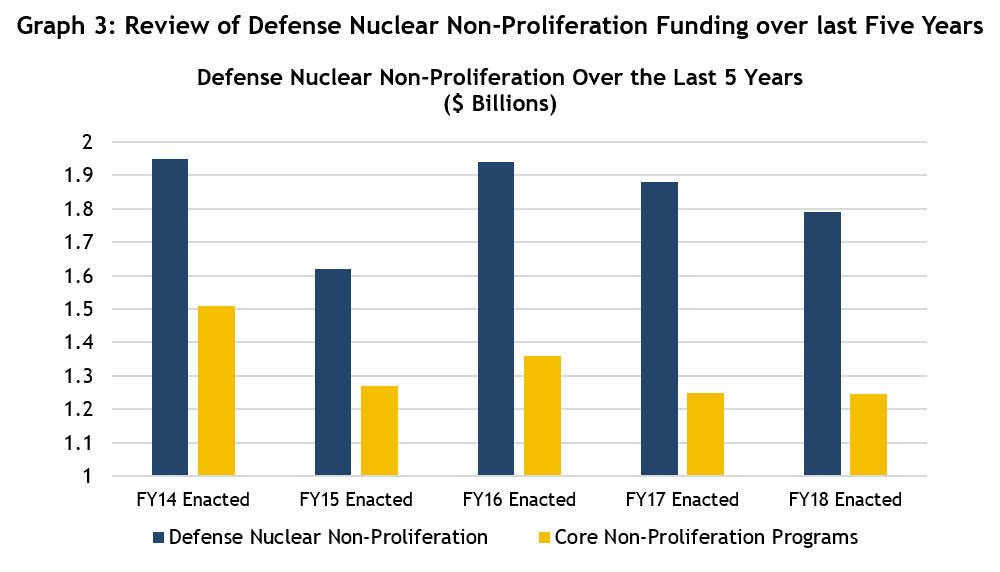Click here for a PDF version of the briefing book.

The Fiscal Year 2018 Budget in Context
Introduction
President Trump’s Fiscal Year 2018 budget requests $574.5 billion for the Defense Department’s annual “base” discretionary budget, which is $58.4 billion higher than FY 17 levels, and $50.6 billion above last year’s request from President Obama. This amount does not include certain other security spending, including funding for nuclear weapons-related work in the Department of Energy. Nor does it include an additional request of $64.6 billion for the Pentagon’s portion of the Overseas Contingency Operations (OCO) account – also referred to as “war funding.” Including all of these accounts, the total national defense discretionary spending request is $667.6 billion (see Table 1). As an uncapped account, the OCO fund is often used to push military spending above the maximum levels allowed by law. On its own, the requested OCO level would represent the fourth largest United States federal agency by budget.
Overseas Contingency Operations
The $64.6 billion request for OCO includes:
- $45.9 billion for military operations in Afghanistan and training Afghan security forces (Operation Freedom’s Sentinel)
- $13.0 billion for operations in Iraq and Syria (Operation Inherent Resolve) and anti-terrorism funding and operations against the Islamic State
- $4.8 billion for the European Reassurance Initiative (ERI)
- $0.9 billion for Security Cooperation, formerly known as the Counterterrorism Partnership Fund
In addition to the $64.6 billion OCO funding requested for the Pentagon, the Administration is also proposing $12.0 billion for OCO in the State Department/USAID FY 2018 request, a reduction of $7.1 billion compared to FY 2017. The State Department/USAID requested base budget is $25.6 billion, a reduction of $10.1 billion compared to FY 2017. In total, the amount requested for the Department of State and USAID is $37.6 billion, a reduction of approximately $17 billion compared to FY 2017.
Nuclear Modernization and Non-Proliferation
The request increases funding for nuclear weapons refurbishment plans, which aim to overhaul and maintain the entire nuclear arsenal at a cost of up to $1 trillion over 30 years. This plan includes funding for a new long-range bomber, a new nuclear-capable cruise missile, a new ballistic missile submarine program, an updated land-based intercontinental ballistic missile (ICBM), and their associated warheads. Actualizing these plans will likely result in decreased funding for conventional military capabilities.
The budget also proposes a $90 million cut to the Defense Nuclear Non-Proliferation account compared to the amount enacted last year. These cuts include a $30 million reduction of the Global Material Security program, which works to reduce and protect vulnerable nuclear and radiological material located around the globe, and a further $24 million cut for non-proliferation research and development.
The President’s Request
Table 1: Discretionary Defense Request for Fiscal Year 2018
(in billions of current dollars)
| FY 2017 Enacted: | FY 2018 Funding Request: | Allocated to: |
| 516.1 | 574.5 | Department of Defense Base Budget (051) |
| 82.4 | 64.6 | Overseas Contingency Operations (War Funding) |
| 19.7 | 20.6 | Defense Related Activities at DOE (053) |
| 8.2 | 7.9 | Other Defense Related Funding (054) |
| 626.4 | 667.6 | Total National Defense Spending Request (050) |
| Time Period | FY Enacted: |
National Defense Spending: (in billions of 2009 dollars*)
|
| World War II | 1945 | 994 |
| Korean War Peak Spending | 1953 | 532 |
| Vietnam War Peak Spending | 1968 | 524 |
| Peak 1980’s Buildup Spending | 1988 | 533 |
| Proposed Current Spending | 2018 | 564 |
*Provided by the Office of Management and Budget

Table 3: Fiscal Year 2018 Base + OCO Discretionary Defense Request by Function
(in billions of current dollars)
| FY 2017 Enacted**: | FY 2018 Funding Request: | Allocated to: | Delta FY17-FY18 | FY17 % | FY18 % |
| 138.9 | 146.0 | Military Personnel | +7.1 | 23.7% | 22.8% |
| 249.1 | 271.9 | Operations & Maintenance | +22.8 | 42.5% | 42.5% |
| 119.7 | 125.2 | Procurement | +5.5 | 20.4% | 19.6% |
| 69.9 | 83.3 | Research and Development (RDT&E) | +13.4 | 11.9% | 13.0% |
| 7.9 | 10.4 | Construction/Family Housing | +2.5 | 1.3% | 1.6% |
| 1.3 | 2.2 | Revolving & Management Funds | +0.9 | 0.2% | 0.3% |
| 586.8 | 639.1 | Total* | +52.3 | 100% | 100% |
*May not add up due to rounding
**Numbers provided by the Pentagon. Omnibus appropriations adopted in May 2017 may not be included.
Table 4: Fiscal Year 2018 Base + OCO Discretionary Defense Request by Service
(in billions of current dollars)
| FY 2017 Enacted**: | FY 2018 Funding Request: | Allocated to: | Delta FY17-FY18 | FY17 % | FY18 % |
| 151.1 | 166.0 | Army | +14.9 | 25.7% | 26.0% |
| 168.9 | 180.0 | Navy | +11.1 | 28.8% | 28.2% |
| 163.6 | 183.0 | Air Force | +19.4 | 28.1% | 28.6% |
| 103.1 | 110.1 | Defense-Wide | +7.0 | 17.6% | 17.2% |
| 586.7 | 639.1 | Total* | +52.4 | 100% | 100% |
*May not add up due to rounding
**Numbers provided by the Pentagon. Omnibus appropriations adopted in May 2017 may not be included.
Nuclear Weapons and Non-Proliferation
Table 5: Fiscal Year 2018 Request for National Nuclear Security Administration (NNSA)
(in billions of current dollars)
| FY 2017 Enacted: | FY 2018 Funding Request: | Allocated to: |
| 1.88 | 1.79 | Nuclear Non-Proliferation |
| 9.25 | 10.24 | Weapons Activities |
| 0.39 | 0.42 | Federal Salaries and Expenses |
| 1.42 | 1.48 | Naval Reactors |
| 12.94 | 13.93 | Total NNSA Request* |
*May not add up due to rounding
Table 6: Fiscal Year 2018 Request for Defense Nuclear Non-Proliferation
| *May not add up due to rounding |
(in millions of current dollars)
| FY 2017 Enacted | FY 2018 Funding Request: | Allocated to: |
| 367.1 | 337.1 | Global Material Security |
| 288.4 | 332.1 | Material Management and Minimization |
| 335 | 279.0 | Non-Proliferation Construction |
| 124.7 | 129.7 | Non-Proliferation and Arms Control |
| 469.8 | 446.1 | Non-Proliferation Research and Development |
| 271.9 | 277.4 | Nuclear Counterterrorism and Incident Response Program |
| 83.2 | 40.5 | Legacy Contractor Pensions |
| -57.2 | -49 | Prior Year Balance |
| 1,882.9 | 1,793.3 | Total Defense Nuclear Non-Proliferation Request* |
*May not add up due to rounding
Table 7: Review of Defense Nuclear Non-Proliferation Funding Over Last Five Years
| FY14 Enacted | FY15 Enacted | FY16 Enacted | FY17
Enacted |
FY18
Requested |
FY18 vs. FY17 | |
| Defense Nuclear Non-Proliferation | $1.95 billion | $1.62 billion | $1.94 billion | $1.88 billion | $1.79
billion |
– $90 million |
| Core Non-Proliferation Programs* | $1.51 billion | $1.27 billion | $1.36 billion | $1.25 billion | $1.245
billion |
– $5 million |
*Includes Global Material Security, Material Management and Minimization, Nonproliferation and Arms Control, Defense Nuclear Nonproliferation R&D.
State Department and Foreign Operations
Table 8: State Department/ Diplomatic Total Funding
In Billion ($)
| FY 16 Actual | FY 17 Estimate * | FY18 Request | |
| State Department/USAID | 51.1 | 54.9 | 37.6 |
*Number provided in President’s FY18 Request.
Table 9: State Department – Key Department Funding
In Millions ($)
| FY 16 Actual | FY17 Estimate * | FY18 Request | |
| Peacekeeping Operations | 600.6 | 650.4 | 301.4 |
| International Security & Nonproliferation (ISN) | 45.5 | 45.1 | 42.2 |
| Arms Control, Verification, and Compliance (AVC) | 31.7 | 31.8 | 30.6 |
| Political-Military Affairs | 47.5 | 47.1 | 45.7 |
*Number provided in President’s FY18 Request.
Table 10: State Department – Nonproliferation, Antiterrorism, Demining and Related Programs
In Millions ($)
| FY16 Actual | FY 17 Appropriation | FY18 Request | |
| Global Threat Reduction | 70.0 | 70.0 | 65.1 |
| IAEA Voluntary Contribution | 88.0 | 94.8 | 91.9 |
| Nonproliferation and Disarmament Fund | 30.0 | 30.0 | 5.0 |
| Terrorist Interdiction Program | 26.2 | 33.0 | 36.0 |
Table 11: State Department/ USAID – Select Eliminated Programs
In Millions ($)
| FY 16 Actual | FY17 Estimate | FY18 Request | |
| International Bank for Reconstruction and Development | 1,197.1 | 1,194.9 | 0 |
| Asian Development Fund | 105.0 | 104.8 | 0 |
| Clean Technology Fund | 170.9 | 170.4 | 0 |
| Strategic Climate Fund | 59.6 | 59.5 | 0 |
| Global Agriculture and Food Security Program | 43.0 | 42.9 | 0 |
| U.S. Emergency Refugee and Migration Assistance (ERMA) | 50.0 | 49.9 | 0 |
Table 12: Request for Fiscal Year 2018 Selected Nuclear Weapons
(in millions of current dollars)
| FY 2017 Appropriated: | FY 2018 Funding Request: | Allocated to: |
| 1,338.3 | 2,000 | Long Range Strike Bomber* |
| 1,687.6** | 1,884.5 | Ohio Submarine Replacement Program (Columbia Class) |
| 616.1 | 788.6 | B61 Life Extension Program |
| 1,222.6 | 1,270 | Trident II Ballistic Missile Modifications |
| 113.9 | 215.7 | Ground Based Strategic Deterrent |
| 95.6 | 451.3 | Long-Range Standoff Weapon |
| 220.3 | 399.1 | W80-4 Life Extension Program |
| 222.9 | 224.1 | W76-1 Nuclear Life Extension Program |
| 281.1 | 332.3 | W88 Nuclear Alteration Program |
*Long range strike bomber will serve both conventional and nuclear missions
**Does not represent total appropriation, some R&D not included



